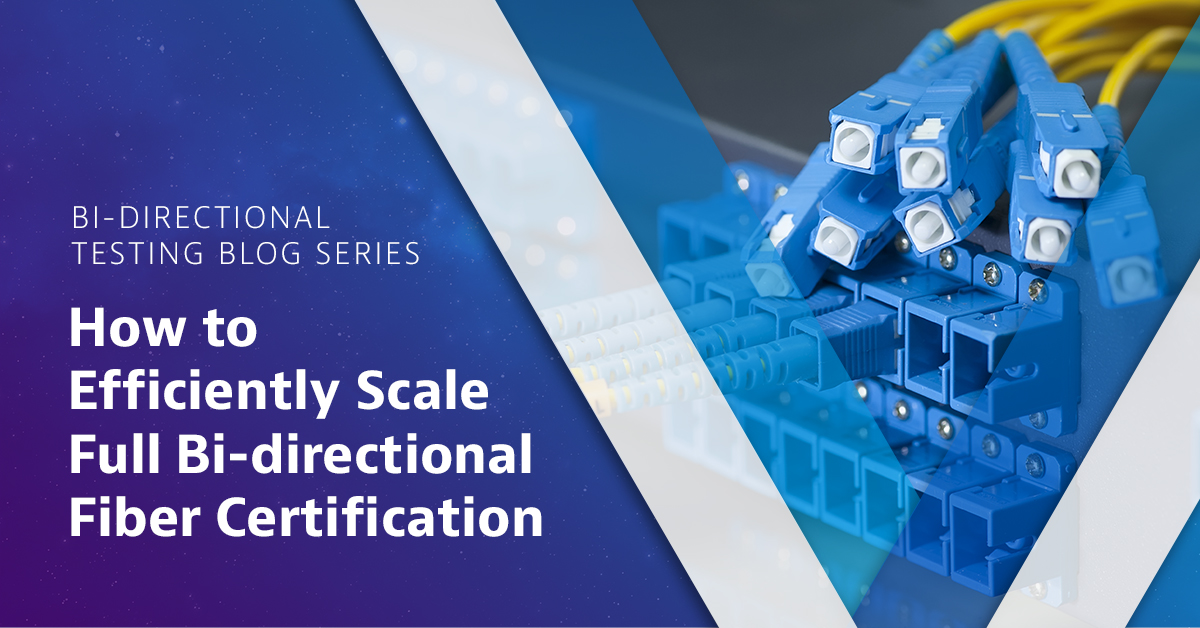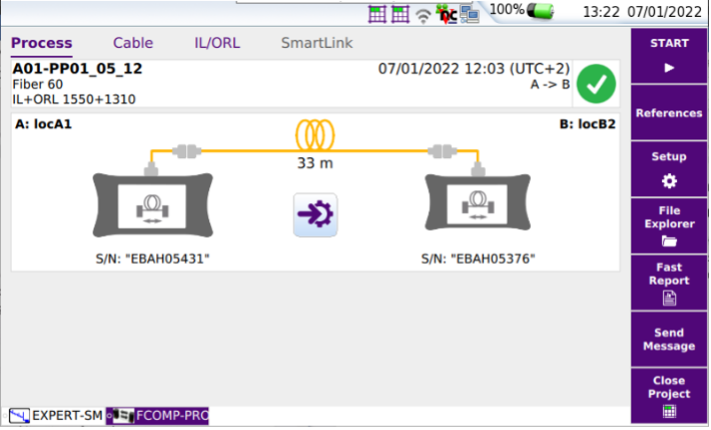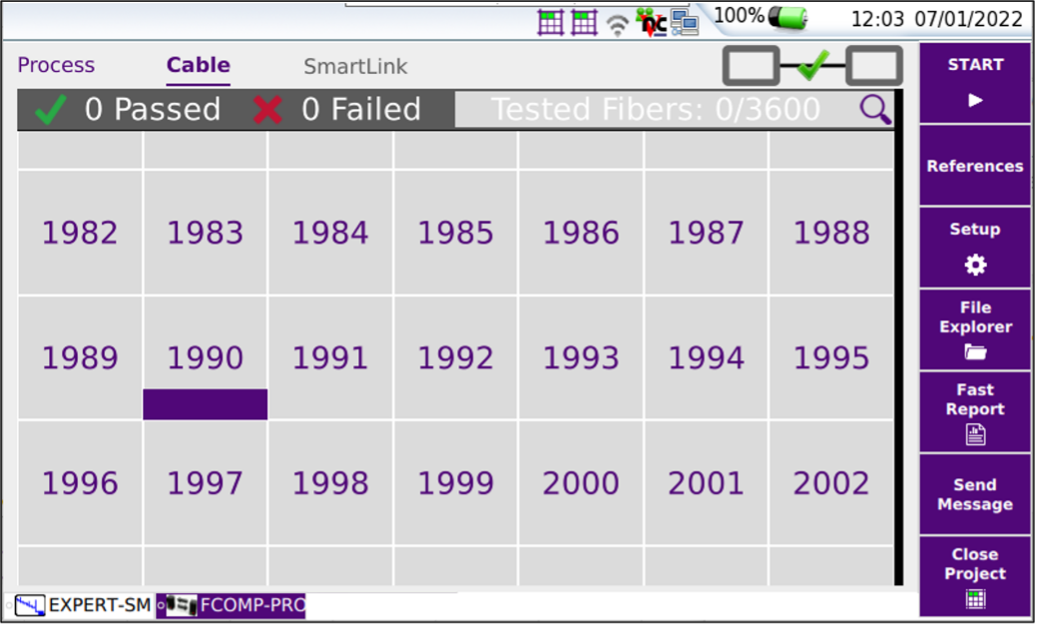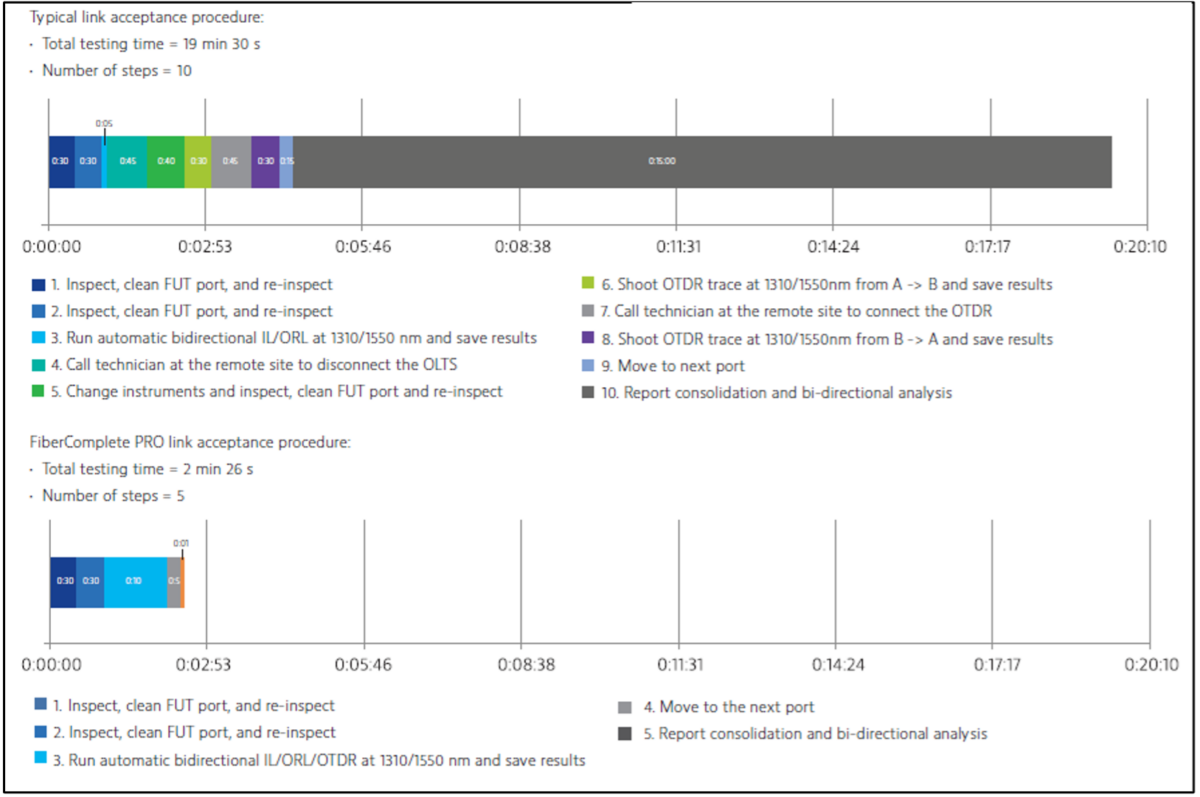How to Efficiently Scale Full Bi-Directional Certification for High-Fiber-Count Cables

Following on from earlier blogs about the value of bi-directional (bi-dir) fiber certification it’s clear that performing full bi-dir IL, ORL, and OTDR testing gives a much deeper insight into the condition and quality of a fiber link and ultimately will reduce ongoing maintenance costs, give better service performance, and extend a network’s operational life. However, there is extra work involved when you include the extra bi-dir tests. And if you are not careful with choice of test equipment, with how test sequencing is implemented, and the level of automation adopted or available (particularly with the bi-dir OTDR analysis), you can and probably will run into issues with excessive testing time, logistics, additional post-test processing work/cost, and potential delays signing off fiber build projects.
Traditional techniques and approaches for bi-dir test may be ok for lower volumes of fiber, but when you are faced with deploying high-fiber-count cables with hundreds or even thousands of fibers ,and you start to scale up the time it takes to test and cert each fiber into the thousands, you see that it rapidly becomes almost unfeasible in terms of time required.
You need a new or evolved approach that puts workflow efficiency at its core, employs more automation, enables batch testing, and removes as many manual and complex processes as possible, particularly the post-test bi-dir OTDR analysis.
Let’s examine the issues with traditional approaches and what a better solution might look like.
First, multiple test ports or test sets, one for IL and ORL, another for OTDR. The drawback is that you have to physically switch or move the fiber under test between the ports and manually re-start testing, which interrupts the test flow and wastes time. You run one set of tests, IL and ORL, then have to go back and run the OTDR test. If you are doing all of these tests bi-directionally you also have to call or radio the far-end tech to coordinate tests to make sure you are both ready and have the correct test port connected or the fiber end terminated or un-terminated, receive fiber connected etc..
A better approach would be to make all tests available through a single test unit and single test port and let the instrument(s) coordinate the test sequences automatically. This would remove the need to physically switch between test ports and eliminate the delays switching between tests, plus the interruption and then manual restarting of the testing sequence. It would also reduce delays due to extra inspection and cleaning cycles of the test ports and launch cable connectors.
Second, coordinating tests from each direction using phones or radio. It may not seem like much, but there are small delays that creep in with each call/conversation that start to add up. Although not a huge amount of that time could be used for something else—for example to improve your workflow and be more time efficient by prepping and inspecting the next fiber or batch of fibers for test while the instrument(s) take care of coordinating the bi-directional tests by using the fiber under test as a communications channel. This also means that you don’t have to mess around connecting instruments to the internet/cloud to provide comms between near and far end units (assuming that you even have easy/reliable connectivity where you are working).
And third, bi-dir OTDR analysis as a post-test activity where results are retrieved from the test instrument(s) and analyzed to generate the bi-dir pdf report. Setting aside all the challenges about time to retrieve results from instruments, possible file naming errors that mean test data is lost, and so on … this activity requires time and effort (cost) from an additional engineer plus the analysis software license. It can add days to the certification, audit, and sign-off process. And as this is carried out after all the testing is done, i.e. once a tech has left the site, it means if there are any issues you have to go back to fix and/or retest, which is basically time and money.
A far more efficient way to conduct bi-dir tests would be to exchange test result data immediately and again automatically via the fiber under test to perform the bi-dir OTDR analysis on the instrument. That way you get instant results which will allow you to determine if there is a real issue to fix and if necessary, perform any corrective actions before you leave the site. It also removes all post-test processing work, providing a dramatic time saving and significant improvement in workflow.

FiberComplete PRO data exchange via fiber under test (patented)
There are already approaches that attempt to address this post-processing activity by utilizing the cloud and cloud applications to exchange test results between instruments performing the testing at either end of a link. But they can be impractical as they require additional setup (the internet connection, the instrument account in the cloud application) and human intervention to trigger result file upload/download. And this also interrupts the test flow and introduces delays which again become significant when multiplied up to thousands of fiber links … and do you always have or are you always allowed an internet connection (think data center no RF rules for Bluetooth or WiFi tethering)?
Manual project and progress tracking with spreadsheets is another area that carries a risk of error or abuse. It’s a kind of swivel chair approach where a techs/contractors initiate tests on an instrument and then record fiber IDs and record pass/fail status on a spreadsheet. These spreadsheets have to be submitted or collected regularly and returned to a project manager or lead engineer for validation and compilation into project progress reporting but as with most things there can be delays with spreadsheet submission leading to reporting delays. Entering information manually on a spreadsheet carries the risk of typo’s which could mean information is lost or becomes useless, which can mean a site revisit for retesting.
Again, the manual effort and time may be ok for lower volumes of fibers but is not efficient enough and does not scale well to hundreds or thousands of fibers, it simply takes too long.
The way to tackle this piece of the puzzle would be an approach that reduces the amount of manual data entry and automatically ties results/reports to those fiber IDs, essentially integrating the project management aspect into the instrument so that all the fiber ID’s to be tested are pre-defined (no risk of data entry errors), the test equipment can then automatically tie test results to the fiber ID, apply pass/fail thresholds and provide a clear view of project/testing progress.

FiberComplete PRO with Cable-SLM for managing high volume fiber certification projects
Adopting any of these approaches will improve test time or workflow and improve your techs’ efficiency, meaning you can get test jobs finished in a shorter time, freeing your techs up to do more per day or to allocate less time for certification (man hours cost) or just to ensure that the certification doesn’t delay project sign off. VIAVI believes if you adopt a solution which incorporates all of these items you can cut the time taken for the full end-to-end process (job allocation, test setup, multi-fiber test, bi-dir analysis and report generation) by anything from 70 to 80% (depending on the application).

FiberComplete PRO single fiber test time study
With such time savings performing full bi-dir certification for high fiber count applications doesn’t become time prohibitive. In the next blog we’ll look at a multi-fiber scenario and compare traditional/legacy processes against a solution that adopts the improvements discussed here.
For more information about bi-directional fiber certification take a look at our FiberComplete PRO page.
This blog is part of a 7-part series on bidirectional fiber testing. The rest of the series can be found here:
- Why Perform Bi-directional Fiber Testing?
- What the Standards Say About Bi-directional OTDR Testing
- Single-Unit vs Dual-Unit Test for Bi-directional OTDR Certification
- Is OTDR Testing Using a Loopback Method the Most Efficient Option for Fiber Certification?
- The Impact of Test Equipment Implementation on Full Bi-directional Test: Time Studies
- Job Efficiency: How to Scale Processes, Job Allocation, and Tracking for High-Fiber-Count Projects
 Douglas Clague is currently solutions marketing manager for fiber optic field solutions at VIAVI. Doug has over 20 years of experience in test and measurement with a primary focus on fiber optics and cable technologies, supporting the telecommunications industry. Prior to VIAVI, Doug held positions as manufacturing engineer, solutions engineer and business development manager. Doug has participated on numerous industry panels around fiber and cable technology trends. He attended Brunel University in London and graduated with an honors degree in electrical and electronic engineering.
Douglas Clague is currently solutions marketing manager for fiber optic field solutions at VIAVI. Doug has over 20 years of experience in test and measurement with a primary focus on fiber optics and cable technologies, supporting the telecommunications industry. Prior to VIAVI, Doug held positions as manufacturing engineer, solutions engineer and business development manager. Doug has participated on numerous industry panels around fiber and cable technology trends. He attended Brunel University in London and graduated with an honors degree in electrical and electronic engineering.




